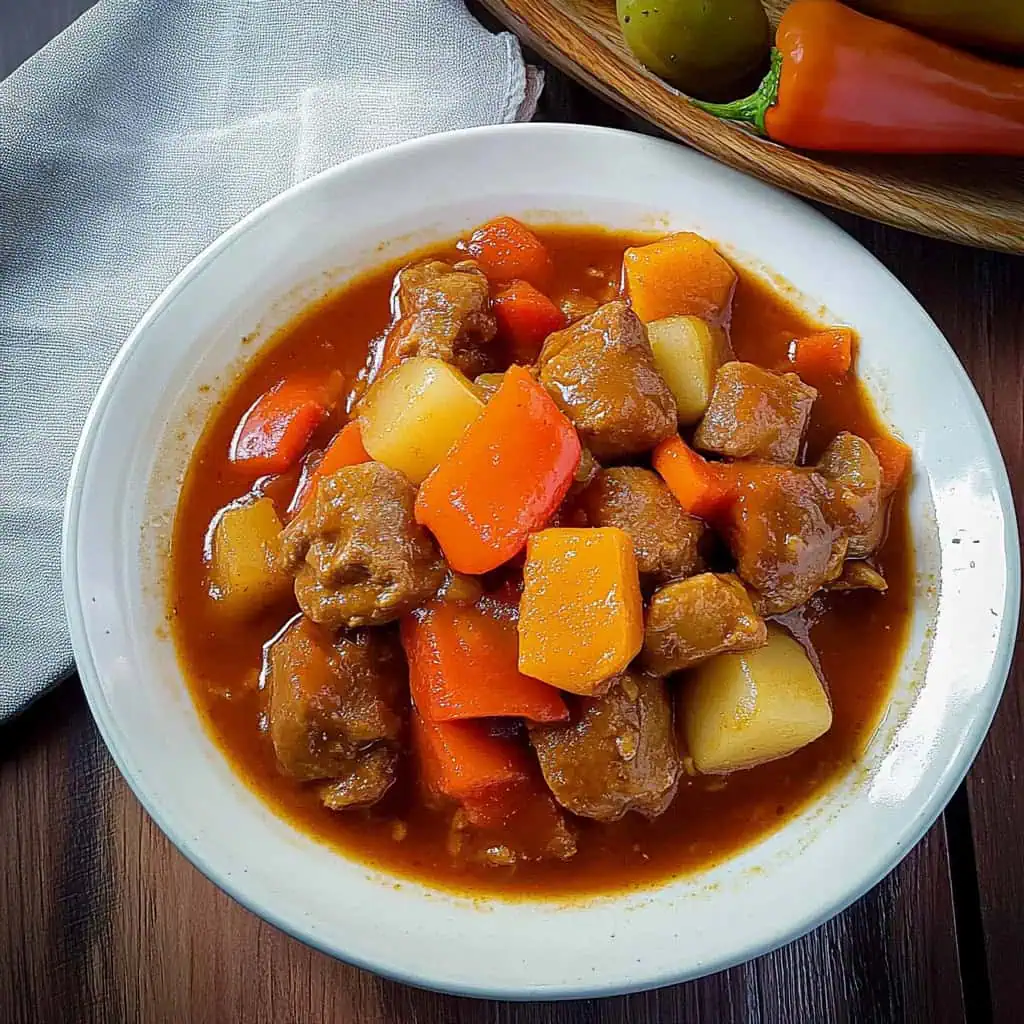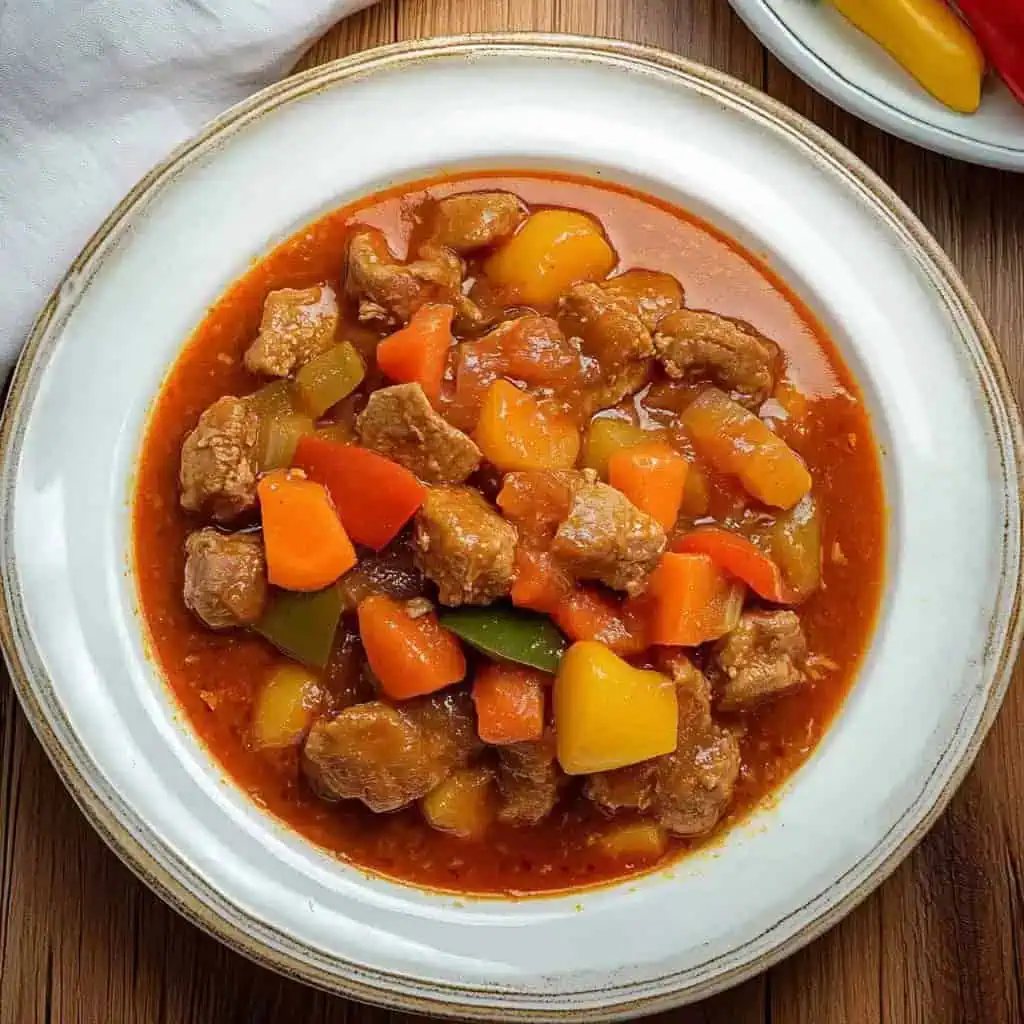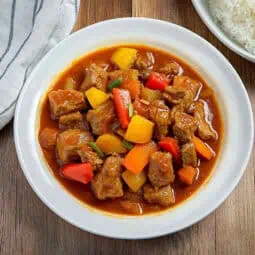Every Monday morning, as the sun peeks through my kitchen window, I find myself making this Filipino Pork Menudo recipe that my Lola taught me years ago. The familiar aroma of garlic and tomatoes sautéing in the pot instantly brings me back to her tiny kitchen in Bataan, where she'd carefully show me how to cut the pork into perfect little cubes.
This isn't just any Filipino pork menudo recipe, it's a fool-proof version that I've perfected over countless family gatherings and potluck parties, where even my Tita, who rarely gives cooking compliments, asked for the recipe (success!).
This menudo recipe hits differently: tender chunks of pork that melt in your mouth, liver that even the kids won't pick out, and a rich, orange-red sauce that will have you reaching for extra rice.
This recipe will guide you to create that authentic Pinoy pork menudo that tastes like family lunches and the comfort of home.
Jump to:

Why You'll Love This Recipe
- Perfect Balance: Tender meat meets colorful vegetables in a rich, tomato-based sauce
- Make-Ahead Friendly: Tastes even better the next day
- Budget-Friendly: Uses simple, accessible ingredients
- Versatile: Great for daily meals or special occasions
- Forgiving Recipe: Easy to adjust and customize to your taste
- Family-Approved: Even picky eaters love this version
Ingredients
Each component in this menudo plays a vital role in creating the perfect balance of flavors and textures. Pork shoulder provides hearty, tender meat while liver adds richness and depth.
The combination of bright tomatoes, savory aromatics, and colorful vegetables creates the iconic sweet-savory profile, with annatto seeds providing the signature orange-red color. Raisins add subtle sweetness to balance the savory elements, while potatoes and garbanzos create heartiness that makes this dish so satisfying.

For the Meat Base:
- 2 lbs pork shoulder (kasim), cut into 1-inch cubes
- ½ lb pork or beef liver (atay), cut into 1-inch cubes
- 2 tablespoons cooking oil (mantika)
- 1 teaspoon annatto seeds (atsuete)
For the Aromatics:
- 1 large onion (sibuyas), finely chopped
- 6 cloves garlic (bawang), minced
- 6 large ripe tomatoes (kamatis), diced
- 2 tablespoons fish sauce (patis)
For the Vegetables:
- 3 medium potatoes (patatas), cubed, same size as meat
- 2 large carrots, cubed, slightly smaller than potatoes
- 1 red bell pepper, cubed into ¾-inch squares
- 1 green bell pepper, cubed into ¾-inch squares
- 1 can (16 oz) garbanzo beans (garbanzos), drained
- ¼ cup raisins (pasas)
For the Sauce:
- 2 cups water (tubig)
- 2 bay leaves (dahon ng laurel)
- 1 tablespoon tomato paste (optional, for richer color and flavor)
- Salt (asin) and pepper (paminta) to taste
Equipment
- Heavy-bottomed Dutch Oven or Pot (Kaldero): Distributes heat evenly to prevent scorching and allows for proper simmering. A 6-quart size works perfectly for this recipe.
- Sharp Chef's Knife: Creates the uniform meat and vegetable cubes that define authentic menudo and ensure even cooking.
- Wooden Spoon (Sandok): Allows gentle stirring without breaking up the delicate ingredients and won't scratch your cookware.
- Measuring Cups and Spoons: Ensures proper proportions for balanced flavor.
- Fine Mesh Strainer: For removing annatto seeds and draining garbanzos.
- Kitchen Timer: Helps track cooking times for perfectly tender—not mushy—vegetables.
- Small Bowl: For soaking liver in milk (an essential step for removing bitter flavor).
- Cutting Board: Preferably with a juice groove to capture tomato juices.

How To Make
- Prepare the Meat: Cut the pork shoulder into uniform 1-inch cubes and place in a bowl. Cut the pork liver into similar-sized cubes, keeping it separate. Soak the liver in milk for 30 minutes to remove any bitter taste and tenderize it.
- Prep the Vegetables: While the liver soaks, prepare your vegetables. Peel and cut the potatoes and carrots into cubes slightly smaller than the meat (this ensures even cooking). Dice the bell peppers into ¾-inch squares. Finely chop the onion, mince the garlic, and dice the tomatoes.
- Create Annatto Oil: Heat your Dutch oven over medium heat (350°F/175°C). Add cooking oil and annatto seeds. Stir continuously until the oil turns a rich orange color (about 2 minutes). Remove and discard the seeds using your strainer or slotted spoon.
- Build the Flavor Base: In the orange-tinted oil, sauté the chopped onions until translucent (2-3 minutes). Add the minced garlic and cook until fragrant but not browned (1 minute). Add the diced tomatoes and cook until they soften and release their juices (about 5 minutes).
- Develop the Meat Flavor: Add the cubed pork to the pot and cook until it browns on all sides (5-7 minutes). Pour in the fish sauce and stir to coat the meat. Add water and bay leaves. Bring to a boil, then reduce heat to low (300°F/150°C). Cover and simmer for 30-35 minutes until the pork becomes fork-tender.
- Add Hardy Vegetables: Once the pork is tender, add the cubed potatoes and carrots. Cook for 5 minutes at medium-low heat (325°F/165°C).
- Incorporate Delicate Ingredients: Add the bell peppers and drained garbanzo beans. Drain the liver from the milk, pat it dry, and add it to the pot along with the raisins.
- Finish Cooking: Cook for another 5-7 minutes until the liver is just cooked through but still tender, and the vegetables are crisp-tender. The potatoes should be easily pierced with a fork but still holding their shape.
- Perfect the Sauce: If the sauce is too thin, remove the lid and let it simmer until it reaches your desired thickness. The ideal sauce should coat the back of a spoon. Add tomato paste at this stage if you want a deeper color and flavor.
- Rest Before Serving: Let the menudo rest for 5-10 minutes before serving. This allows the flavors to settle and the sauce to thicken slightly. Serve hot over steamed white rice (kanin).

Tips from Lola's Kitchen
- Perfectly Tender Meat: For exceptionally tender pork in less time, add a small piece of pineapple (about 1-inch cube) during simmering. The natural enzymes break down the meat fibers. Remove before serving.
- Liver Perfection: Beyond the milk soak, add the liver only in the final 5-7 minutes of cooking. This prevents it from becoming tough and maintains its rich texture.
- Sauce Consistency Secret: Instead of using cornstarch, mash approximately ¼ of one potato into the sauce during the last 5 minutes of cooking for natural thickening.
- Flavor Intensification: For special occasions, substitute ½ cup of the water with good-quality red wine for remarkable depth.
- Uniform Cutting Technique: Cut all ingredients into similar sizes, but make potatoes and carrots slightly smaller than meat as they take less time to cook.
- Maximum Color Development: Toast the annatto seeds in hot oil until they begin to pop slightly for the most vibrant natural color.
Substitutions
- Meat Options:
- Chicken thighs (cut into 1-inch pieces) for a lighter version
- Beef chuck for a heartier stew (increase cooking time by 30 minutes)
- Pork belly (liempo) for richer flavor and mouthfeel
- Skip liver entirely and add 2 extra tablespoons of tomato paste for depth
- Vegetable Substitutions:
- Green peas (gisantes) instead of garbanzo beans
- White potatoes can be substituted with sweet potatoes for a nutritional boost
- Parsnips can replace carrots for a unique twist
- No fresh tomatoes? Use 1 can (14 oz) diced tomatoes instead
- Flavor Enhancers:
- Replace fish sauce with soy sauce plus ½ teaspoon sugar
- No annatto seeds? Use 1 teaspoon paprika plus ¼ teaspoon turmeric
- Add 2-3 Filipino-style hotdogs (sliced) for traditional color and flavor
- Substitute raisins with 1 tablespoon brown sugar for subtle sweetness
Troubleshooting
Tough Meat
- Problem: Pork remains tough despite long cooking
- Solutions:
- Cut meat against the grain to break up muscle fibers
- Extend simmering time by 15-minute increments
- For quick meals, use a pressure cooker (25 minutes on high pressure)
- Ensure heat is low enough for a true simmer, not a boil
Watery Sauce
- Problem: Sauce is too thin and lacks richness
- Solutions:
- Remove lid and simmer for 10-15 minutes to reduce
- Mash some potato pieces directly into the sauce
- Add 1-2 tablespoons tomato paste
- In emergencies, make a slurry of 1 teaspoon cornstarch with 1 tablespoon cold water
Bitter Taste
- Problem: Slight bitterness in finished dish
- Solutions:
- Always soak liver in milk before cooking
- Don't overcook the garlic (it should be golden, not brown)
- Add ½ teaspoon sugar to balance flavors
- Ensure annatto seeds are removed completely before continuing
Vegetables Too Soft
- Problem: Vegetables lose shape and become mushy
- Solutions:
- Add potatoes and carrots only after meat is already tender
- Time vegetable cooking precisely (set a timer)
- Cut vegetables slightly larger if they consistently overcook
- Add delicate vegetables like bell peppers only in the final 5 minutes
Storage & Reheating
Refrigeration
- Cool menudo completely before refrigerating (within 2 hours of cooking)
- Store in airtight containers, separating into meal-sized portions
- Keeps fresh for 3-4 days in the refrigerator
- Flavors actually improve overnight as ingredients marry
Freezing
- For longer storage, freeze in freezer-safe containers for up to 3 months
- Leave ½-inch headspace for expansion
- Label with date and contents
- Thaw overnight in refrigerator before reheating
Reheating Methods
- Stovetop (Best Method):
- Reheat in a covered pot over low heat (165°F/75°C)
- Add 2-3 tablespoons of water if sauce has thickened too much
- Stir occasionally to prevent scorching
- Heat until internal temperature reaches 165°F (use food thermometer)
- Microwave (Quick Method):
- Place portion in microwave-safe container
- Cover with microwave-safe lid or paper towel
- Heat on medium (70%) power in 2-minute intervals
- Stir between intervals for even heating
- Let stand 1 minute before serving

FAQ
Can I make Filipino pork menudo in advance?
Yes! In fact, menudo tastes even better the next day as the flavors continue to develop. Make it up to 2 days ahead and reheat gently when ready to serve. Many Filipino families intentionally make it a day ahead for special gatherings.
Is liver absolutely necessary in authentic menudo?
While traditional menudo includes liver for its distinctive richness, you can omit it if you prefer. To compensate for the lost depth of flavor, add an extra tablespoon of tomato paste and a teaspoon of soy sauce.
How can I make menudo less acidic?
If your tomatoes are particularly acidic, add ½ teaspoon of sugar to balance the flavors. You can also reduce the amount of fresh tomatoes and increase the raisins slightly for natural sweetness.
Why is my liver always tough?
Liver becomes tough when overcooked. The key is to: 1) soak it in milk for 30 minutes before cooking, 2) add it only in the final 5-7 minutes of cooking, and 3) make sure it's cut into uniform pieces for even cooking.
Can I use other meats in Filipino menudo?
Absolutely! While pork is traditional, you can use chicken thighs (reduce cooking time to 20 minutes), beef chuck (increase cooking time to 90 minutes), or even a combination. Each meat brings its own character to the dish.
How do I make the sauce redder like in restaurants?
For that vibrant red-orange color, increase annatto seeds to 2 teaspoons when making the oil, or add 1-2 tablespoons of tomato paste along with a pinch of paprika during the final 10 minutes of cooking.
Is Filipino menudo the same as Mexican menudo?
No, they're entirely different dishes that happen to share a name. Mexican menudo is a tripe soup, while Filipino menudo is a tomato-based stew with pork, liver, and vegetables that evolved during the Spanish colonial period.
Can vegetarians enjoy menudo?
Yes! Create a vegetarian version by substituting the meat with firm tofu (added in the last 10 minutes) and mushrooms (shiitake and button mixed). Use vegetable broth instead of water and substitute fish sauce with soy sauce or liquid aminos.
What makes menudo different from other Filipino tomato-based stews?
Unlike afritada or mechado, menudo is defined by its smaller cut ingredients, the inclusion of liver, and the optional addition of raisins. The combination of potatoes and bell peppers is also distinctive to menudo.
How can I make menudo spicy?
While traditional menudo is mild, you can add heat by incorporating 1-2 chopped bird's eye chilies (siling labuyo) with the aromatics, or 1 teaspoon of chili flakes. Serve extra chili on the side for guests to adjust to their preference.
Related
Looking for other recipes like this? Try these:

Filipino Pork Menudo (Menudong Baboy)
Equipment
- Large heavy-bottom pot
- Sharp knife for uniform cuts
- Wooden spoon for stirring
- Measuring cups/spoons
- Strainer for garbanzos
Ingredients
For the Meat Base:
- 2 lbs pork shoulder kasim, cut into 1-inch cubes
- ½ lb pork or beef liver atay, cut into 1-inch cubes
- 2 tablespoons cooking oil mantika
- 1 teaspoon annatto seeds atsuete
For the Aromatics:
- 1 large onion sibuyas, finely chopped
- 6 cloves garlic bawang, minced
- 6 large ripe tomatoes kamatis, diced
- 2 tablespoons fish sauce patis
For the Vegetables:
- 3 medium potatoes patatas, cubed, same size as meat
- 2 large carrots cubed, slightly smaller than potatoes
- 1 red bell pepper cubed, ¾-inch squares
- 1 green bell pepper cubed, ¾-inch squares
- 1 can 16 oz garbanzo beans (garbanzos), drained
- ¼ cup raisins pasas
For the Sauce:
- 2 cups water tubig
- 2 bay leaves dahon ng laurel
- 1 tablespoon tomato paste optional
- Salt asin and pepper (paminta) to taste
Instructions
- Cut the pork shoulder into uniform 1-inch cubes and place in a bowl. Do the same with the pork liver (atay), but keep it separate. Soak the liver in milk for 30 minutes to remove any bitter taste (ibabad ang atay sa gatas para maalis ang pait).
- While the liver is soaking, prepare your vegetables. Peel and cut the potatoes (patatas) and carrots into cubes slightly smaller than the meat. Dice the red and green bell peppers (siling pangsigang) into ¾-inch squares. Finely chop the onion (sibuyas) and mince the garlic (bawang). Dice the tomatoes (kamatis) into small pieces.
- Heat your thick-bottomed pot (kaldero) over medium heat (katamtamang init, 350°F/175°C). Add cooking oil (mantika) and annatto seeds (atsuete). Stir until the oil turns orange, then remove and discard the seeds using your slotted spoon (sandok na may butas).
- In the orange-tinted oil, sauté the chopped onions until they become translucent (malinaw), about 2-3 minutes. Add the minced garlic and cook until fragrant (mabango), about 1 minute. Add the diced tomatoes and cook until they start to soften and release their juices, about 5 minutes.
- Add the cubed pork to the pot and cook until the meat browns on all sides (lutuin hanggang maging kulay kayumanggi), approximately 5-7 minutes. Pour in the fish sauce (patis) and stir to combine. Add water (tubig) and bay leaves (dahon ng laurel). Bring to a boil, then reduce heat to low (300°F/150°C). Cover and simmer for 30-35 minutes or until the pork becomes tender (malambot).
- Once the pork is tender, add the cubed potatoes and carrots. Cook for 5 minutes at medium-low heat (325°F/165°C). Add the bell peppers and drained garbanzo beans (garbanzos). Drain the liver from the milk, pat it dry, and add it to the pot along with the raisins (pasas).
- Cook for another 5-7 minutes until the liver is just cooked through (lutong-luto) but still tender, and the vegetables are crisp-tender (malutong-malambot). The potatoes should be easily pierced with a fork but still holding their shape. Taste and season with salt (asin) and pepper (paminta) as needed.
- If the sauce is too thin (manipis), remove the lid and let it simmer until it reaches your desired thickness (kapal). The final sauce should be thick enough to coat the back of a spoon. Remember that the sauce will continue to thicken as it cools.
- Let the menudo rest for 5-10 minutes before serving (palamiginin ng kaunti bago ihain). This allows the flavors to settle and the sauce to thicken slightly. Serve hot over steamed white rice (mainit na kanin).
- For leftovers (tira), let the menudo cool completely before transferring to an airtight container. When reheating (pag-iinit), warm gently over low heat (mababang init, 165°F/75°C), adding a small amount of water if needed to maintain the sauce consistency. Stir occasionally to ensure even heating.
- Note: Like many Filipino stews, menudo often tastes better the next day (mas masarap kinabukasan) when the flavors have had time to develop fully. If making ahead, you can cook it up to a day in advance and reheat gently before serving.
Tips from Lola's Kitchen
- Tenderize pork faster by adding a piece of pineapple while cooking
- Soak liver in milk for 30 minutes before cooking to remove bitter taste
- Use pork belly (liempo) for richer flavor
- Add hotdogs for extra flavor and color
- Mash some potatoes to naturally thicken the sauce
Nutrition
The Story Behind Filipino Pork Menudo (Menudong Baboy)
Pork Menudo (Menudong Baboy), not to be confused with its Mexican namesake, holds a special place in Filipino culture as the quintessential family lunch and fiesta favorite. While its name may have Spanish origins, Filipino Menudo evolved into something distinctly local—a hearty, tomato-based stew featuring diced pork, liver, and potato that perfectly exemplifies the Filipino practice of transforming simple ingredients into something extraordinary through patient stewing and careful seasoning.
What makes Filipino menudo fascinating is how it reflects the resourcefulness and practicality of Filipino home cooking. Originally created as a way to make the most of various pork cuts by dicing them into small, uniform cubes (hence the term "menudo" meaning "minute" or small), the dish became beloved for its ability to stretch ingredients to feed large families. The addition of potatoes and carrots not only extended the dish but also absorbed the rich flavors of the sauce, while pork liver added a distinctive richness and depth that became the dish's signature. The bright red-orange sauce, tinted with atsuete (annatto) oil, became so iconic that it's now instantly recognizable at any Filipino gathering.
Today, every region and family has their own version—some add raisins for sweetness, others include hotdogs or chorizo for extra flavor, and some make it saucier or drier depending on local preference. But across all variations, menudo remains a testament to Filipino family values, often cooked in large batches for Sunday family lunches or as baon (packed lunch), tasting even better the next day as the flavors continue to develop.
Remember: The secret to memorable menudo isn't in fancy ingredients but in the patient cutting of ingredients into uniform sizes and the slow simmering that allows the meat to become tender and the flavors to fully meld together.










Comments
No Comments